Lawrence Audio Double Bass Speakers
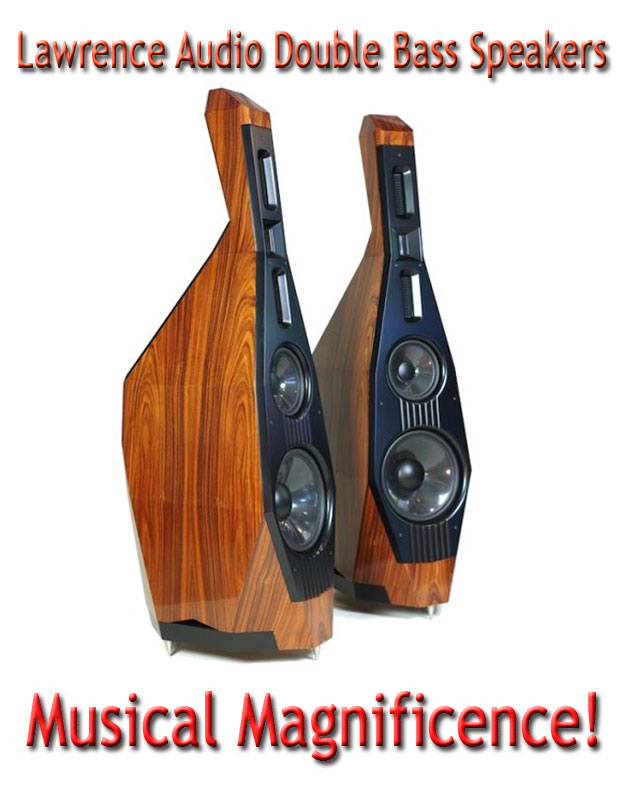
 I have long been a fan of Lawrence Audio speakers. This high-end loudspeaker manufacturer from Taiwan has some of the most beautiful and innovative speaker designs I’ve seen. I first heard one of their loudspeakers (not sure the model) back in mid-2000s when they started showing up at a CES and later, the Rocky Mountain Audio Fest. The sound in their room was always smooth and musical, but what really got my attention was how their speakers resembled musical instruments. I always wondered if that is what contributed to them sounding as good as they did every time I sat before them.
I have long been a fan of Lawrence Audio speakers. This high-end loudspeaker manufacturer from Taiwan has some of the most beautiful and innovative speaker designs I’ve seen. I first heard one of their loudspeakers (not sure the model) back in mid-2000s when they started showing up at a CES and later, the Rocky Mountain Audio Fest. The sound in their room was always smooth and musical, but what really got my attention was how their speakers resembled musical instruments. I always wondered if that is what contributed to them sounding as good as they did every time I sat before them.
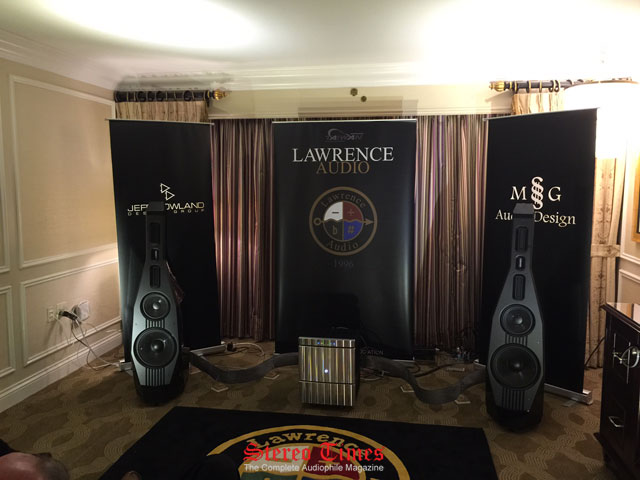 The chief designer for Lawrence Audio is Mr. Lawrence Liao. Mr. Liao is said to be an accomplished musician as well as an artist. I would always see him at the audio shows, quietly watching what was going on in their room, but it was his ever-present Marketing Manager, Angela Yang, making sure that everything ran smoothly. From making sure visitors were comfortable and answering questions for Mr. Liao (she’s also his interpreter), to handing out business cards and literature, Angela Yang is the proverbial “straw that stirs the drink” for Lawrence Audio. I had been expressing an interest in reviewing a pair of their speakers for years, so you can imagine my excitement when Ms. Yang contacted me about an opportunity to review their gorgeous looking Double Bass loudspeakers. You can only learn so much about a speaker at an audio show and let’s face it; there’s nothing like getting a speaker in-home and really putting it through its paces.
The chief designer for Lawrence Audio is Mr. Lawrence Liao. Mr. Liao is said to be an accomplished musician as well as an artist. I would always see him at the audio shows, quietly watching what was going on in their room, but it was his ever-present Marketing Manager, Angela Yang, making sure that everything ran smoothly. From making sure visitors were comfortable and answering questions for Mr. Liao (she’s also his interpreter), to handing out business cards and literature, Angela Yang is the proverbial “straw that stirs the drink” for Lawrence Audio. I had been expressing an interest in reviewing a pair of their speakers for years, so you can imagine my excitement when Ms. Yang contacted me about an opportunity to review their gorgeous looking Double Bass loudspeakers. You can only learn so much about a speaker at an audio show and let’s face it; there’s nothing like getting a speaker in-home and really putting it through its paces.
Construction
A few weeks after I was contacted by Ms. Yang, the speakers finally arrived. Each speaker comes nicely packed in a sturdy wooden crate, wrapped in a soft velvet sock. To unpack the speakers you’ll need to stand the crates upright, remove the front of the crate and take out the piece of wood that holds the neck of the speaker in place. The speaker can then roll right out of the crate on a small base that has wheels. The speakers stay on this small stand until you get them located where you’re going to place them. Simply slide the speaker off the base (this might require a little help so be extra careful), screw in the spikes, and voilà! Your setup is done.
The speakers I received for were breathtakingly beautiful. Fit-n-finish is reminiscent of what you would find on a speaker such as the much more expensive Tidal Contrivas. Well, to be honest, they’re not quite to that standard but they’re not far off it either. The finish (called Gloss Rosewood) was truly special and the color was remarkable, given by the amount of light in my listening room and the amount of light I wanted to shine on them. Initially, the speakers appear to be a deep rich burgundy or cherry color. Once I set them in the listening position, with a little less light, they look like a fine piano black finish until I turn the light on them. Once I got close up on them, I could see the deep wood grain in the speakers. I was greatly impressed by the craftsmanship and attention to detail of the Double Bass.
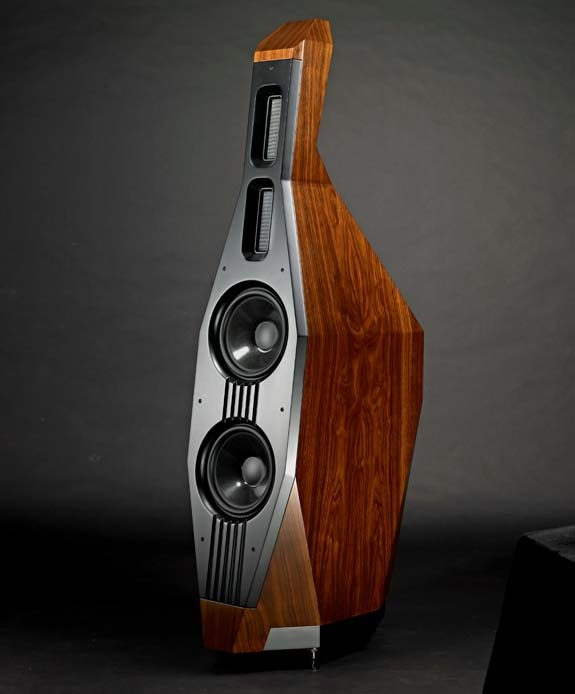
Physically, the Double Bass loudspeaker weighs in at a hefty 115 lbs each and measures 55.1” H x 13.8” W x 19.7” D. The Double Bass is considered a 4-way speaker with vented box loading for the bass. It has two triangular shaped vents toward the bottom of both sides of the speaker for the bass loading. A careful going over of the front baffle reveals that there are five drivers. These drivers are a 2.4” purified aluminum ribbon tweeter driver on the front, surrounded by two 4.7” tweeter/midrange air motion transformers. Pushing the air and delivering the bass are an 8”, non-woven, carbon mid-woofer and a 12”, non-woven carbon bass driver. These drivers have an aluminum frame, a copper-clad aluminum voice coil with flat wire and a special magnet system with a Faraday ring and demodulation coil. On the back of the Double Bass you will find a rear-firing ambient 4.3” aluminum ribbon tweeter. They also utilize four high end WBT connectors that allow for bi-wiring. The Double Bass has a frequency response rated at 24 Hz to 40 kHz and possess a sensitivity rating of 89 dB and an average impedance of eight ohms that never dips below 6.4 ohms. These figures point toward the Double Bass being an easy load to drive.
How it sounds
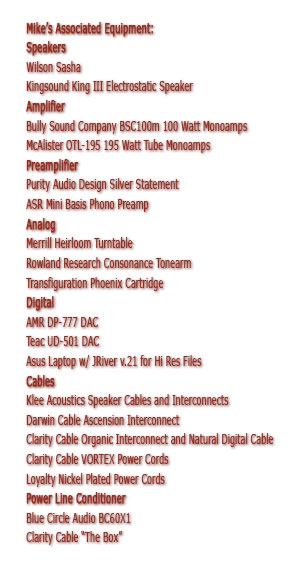 I came away from my initial encounter with the Double Bass speakers very impressed. In my listening room, which is 16’ x 25’, no matter how I had them placed, I had one of the widest, most palpable stages of any speaker I have had the pleasure of entertaining in my room, including the B&W 802, which I could place against the side walls, angle the tweeter and midrange module towards the listening position and still get a realistic stage. Imaging with the Double Bass was outstanding. The Double Bass sounded smooth and effortlessly musical. Tonally, they are slightly to the warm side of neutral, but not by much. In truth, this probably helps create this speaker’s natural sound. Their ribbon drivers give off more of a “you are there” vibe and have no edge to it at all. As you would expect with the ribbon drivers, transient attack and decay and detail performance realistic.
I came away from my initial encounter with the Double Bass speakers very impressed. In my listening room, which is 16’ x 25’, no matter how I had them placed, I had one of the widest, most palpable stages of any speaker I have had the pleasure of entertaining in my room, including the B&W 802, which I could place against the side walls, angle the tweeter and midrange module towards the listening position and still get a realistic stage. Imaging with the Double Bass was outstanding. The Double Bass sounded smooth and effortlessly musical. Tonally, they are slightly to the warm side of neutral, but not by much. In truth, this probably helps create this speaker’s natural sound. Their ribbon drivers give off more of a “you are there” vibe and have no edge to it at all. As you would expect with the ribbon drivers, transient attack and decay and detail performance realistic.
As noted, the Double Bass throws a wide, palpable stage, and the images upon that stage are dimensional and lifelike. When you play your favorite music, not only do the performers feel as though they are in the room but the recorded space is there with all of the air and room sounds or hall sound present. High frequencies are extended, airy and natural, with no brightness, shrill or edginess to its sound. Instruments like triangles and cymbals shimmer as the percussive strikes slowly fade away. The Double Bass did not so much favor one style of music over another, doing them all well, allowing me to enjoy all kinds of music. With that being said, the Double Bass did do a little bit better with orchestral music. I can see why as there are so many things going on in orchestral music to follow and pick up on. You have music going from soft to hard, loud to quiet, and with so many different instruments, tonal colors and so many different orchestral venues, there a lot going on. The Double Bass honestly does an uncanny job of classical music reproduction.
Here are some of the musical sources I used to evaluate the Double Bass. I have recently discovered Tunisian oudist Anouar Brahem’s album, The Astounding Eyes of Rita [ECM Records]. This music is insightful and evocative. I didn’t even know what an oud was until after listening to someone gifted play one. An oud is a stringed instrument that looks like a mandolin with a bent neck. You can hear the Arabic melody in his string playing. On the track, “The Lover of Beirut” the oud and the clarinet lay down the melody for the first half of the track before the rest of the instrumentalists join in. The Double Bass allowed me to follow these totally different sounding independently and yet still have an appreciation for what the instrumentalists were trying to convey in this piece. I came away feeling like I got the message.
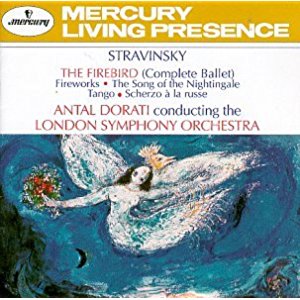 One of my favorite classical music albums is Igor Stravinsky’s The Firebird done by Antal Dorati and the London Symphony Orchestra [Mercury Living Presence 432012-2]. The CD is not as good as the album, yet the performance is noteworthy. The Double Bass showed off its ability to layer an orchestra with this recording and easily allow you to recognize the different sections of the orchestra. As well, it’s ability to allow you hear the hall sounds, the sound of the patron’s stifled coughing their imaging capabilities here as they did a more than credible job replicating a full orchestra, displaying a wide and deep stage with a good deal of layering. Also fun to listen to was the Double Bass ability to capture the lightning and fire explosions as represented by the orchestra’s kettle drums. That was noticeably fun.
One of my favorite classical music albums is Igor Stravinsky’s The Firebird done by Antal Dorati and the London Symphony Orchestra [Mercury Living Presence 432012-2]. The CD is not as good as the album, yet the performance is noteworthy. The Double Bass showed off its ability to layer an orchestra with this recording and easily allow you to recognize the different sections of the orchestra. As well, it’s ability to allow you hear the hall sounds, the sound of the patron’s stifled coughing their imaging capabilities here as they did a more than credible job replicating a full orchestra, displaying a wide and deep stage with a good deal of layering. Also fun to listen to was the Double Bass ability to capture the lightning and fire explosions as represented by the orchestra’s kettle drums. That was noticeably fun.
 Female vocals are another treat to reproduce on a speaker of this caliber. My most favorite female vocalist to listen to is Jane Monheit. Her voice, in a word, is beautiful. Listening to Ms. Monheit singing with Mark O’Connor’s Hot Swing Trio and Wynton Marsalis on the CD, In Full Swing [Odyssey SK 87880] doing “Honeysuckle Rose” and “Misty”, was an ear opening experience. Through the Double Bass her sound was very natural with a startling amount of presence and clarity. The Hot Swing Trio and Wynton Marsalis give excellent support, and Mark O’Connor is one of the best violinists, in a non-classical musical playing role, that I have had the pleasure of listening to. On this album its Ms. Monheit’s purity of tone and vocal reproductions sounding eerily in my room through the Double Bass that win the prize with this offering.
Female vocals are another treat to reproduce on a speaker of this caliber. My most favorite female vocalist to listen to is Jane Monheit. Her voice, in a word, is beautiful. Listening to Ms. Monheit singing with Mark O’Connor’s Hot Swing Trio and Wynton Marsalis on the CD, In Full Swing [Odyssey SK 87880] doing “Honeysuckle Rose” and “Misty”, was an ear opening experience. Through the Double Bass her sound was very natural with a startling amount of presence and clarity. The Hot Swing Trio and Wynton Marsalis give excellent support, and Mark O’Connor is one of the best violinists, in a non-classical musical playing role, that I have had the pleasure of listening to. On this album its Ms. Monheit’s purity of tone and vocal reproductions sounding eerily in my room through the Double Bass that win the prize with this offering.
The Double Bass are one of the most natural sounding speakers I have heard for reproducing pianos. They make pianos sound like the acoustic instruments that they are, due to their exceptional tonality and their ability to make the recorded event sound believably “in the room.” One of the CDs I like to use to demonstrate this is Debussy: Complete Works For Solo Piano, Vol. 2: Preludes, Book 2/Estampes/Children’s Corner [Sony]. What I find to be so captivating is the skill of pianist, Paul Crossley, who makes this disc noteworthy. His finger dexterity is so lightning fast and skillful that he can get harmonies and tonality like I am not used to hearing. The sound is much more appreciable and interesting on the Double Bass.
Final thoughts and a comparison
I found my time with the Lawrence Audio Double Bass speakers to be extremely rewarding, but I was seriously interested in seeing how they would fare against my reference Wilson Audio Sashas since the two speakers are priced competitively and both perform at such high rates. Physically, they are both built to a very high standard. The Sashas are almost twice as heavy and made from some type of resin material which makes the cabinet dead quiet. The Double Bass is made of wood but has several coats of an acrylic material that, similar to the Sashas, makes the finish look like fine furniture and adds weight to the speaker. Fit-n-finish between these two is very close. Once I got the Double Bass and the Sashas set up in my listening room, here is where the differences began to show up. The Sashas, in my opinion, are hyper-critical to setup. I have never heard a speaker have such a varying range of performance just by moving an inch here and two inches there. I found myself talking to the Sashas and asking it them if it was alright to move them here or there and what didn’t it like about choices and why. In a word; nerve wracking.
It took me months of tweaking, adjusting, getting advice from friends and having listening sessions where I would let the pals do all the moving. The best I got them placed was when Joe Jurzec, from Purity Audio Design, came to my home and spent time setting them up. Everybody was happy with them then. The Double Bass, on the other hand, was so much easier to set up. Don’t get me wrong on this. They too can be hyper-critical of 1-2” moves this way and that. I even learned a trick from fellow reviewer, Terry London of Home Theater Review, whereby adding a couple of coins to affect tilt making an appreciable sonic difference. However, at no time during setup did the Double Bass sound amusical. In fact, rolling them out the crates and setting them in a place while you plan to set them up even sounded good. The Double Bass would probably sound musical sitting in the crates in your garage waiting to be setup. Suffice it to say, setup is not a problem with the Double Bass. Do note that the more time you spend setting up with care, the greater the sonic reward there will be.
The Double Bass play music that sounds smoother, slightly more rounded and has a little more ability to draw you into the music and get intimate with the performers. The Sashas are ever so slightly more dynamic and detailed, but not by much. The Double Bass never felt lacking in the detail and dynamics department and with its smoother nature, made more of my music sound more enjoyable and less critical. The Double Bass also speaks with a voice that has greater clarity. I assume there is some tweak or some 1-2” adjustment in my room that will bring more of this quality out of the Sashas, I just have to find it. The bass performance of the Sashas and the Double Bass are both excellent. The Double Bass deep bass extension is warm, full and easily capable of shaking objects in the room. It grabs your attention, especially with acoustic instruments and classical music.
The Sashas, on the other hand will do a slightly better job on rock and pop music, music you’re more likely to go to an outdoor concert for, though the Double Bass performed well with this type of music too. The Sashas bass is deep and full as well, and grabs your attention because it can shake things, not only in your listening room but other rooms in the house. In fairness to the Double Bass, I was delivered a brand new pair that had been played sparingly at a New York audio show and did not have a lot of time spent breaking them in before I got them. The point I want to be clear on is that, with more break-in, the Double Bass woofers will provide greater low end extension and that more air will be moved in your room.
I could go on talking about the similarities and differences between the Double Bass and the Sashas but I’ll sum it up like this: the Double Bass rendered a sound in my listening room that reminded me of being in a jazz club listening to live music that I could listen to all day long and never tire of it. At the same time, it does an outstanding job of reproducing classical music with the orchestra sounding either reserved or going full-tilt in a large orchestral venue. In the end, I am still happy with my selection of the Sashas as my reference but concluded that I could have been just as happy with the Double Bass. Their performance was just as impressive and desirous and recommending them to someone looking for speakers in this price range would be very easy to do. The Double Bass is easy to setup, easy to drive, pleasing to look at and is way up there in the pride of ownership category. I cannot recommend this speaker highly enough.


mike wright
Specifications
Design:4-way vented-box
Frequency Response:24Hz-40kHz
Sensitivity (2.83V/1m):89dB
Impedance:8 ohms(minimum 6.4 ohms)
Power Requirement:50-250W recommended
Tweeter-1,2 Aero striction tweeter, the size of diaphragm (WL):25mm ×120mm, easily field-replaceable for the diaphragm.
Tweeter-3:Purified aluminum ribbon tweeter, the size of aluminum ribbon(LWT): 60mm×8.5mm×0.01mm. High power handling, shielded design,easily field-replaceable for the ribbon.
Tweeter-4(Rear Firing Tweeter):Purified aluminum ribbon tweeter, the size of aluminum ribbon(LWT): 110mm×14.5mm×0.01mm. High power handling, shielded design, easily field-replaceable for the ribbon.
Midwoofer:1×200mm (8″). Aluminum frame, the sandwich cone of Non-woven carbon fiber+Cell+Non-woven carbon fiber, 50mm (2″) copper clad aluminum voice coil with flat wire, the special magnet system with Faraday ring and demodulation coil, 120mm×20mm Y30 Ferrite magnet.
Woofer:1×300mm (12″). Aluminum frame, the sandwich cone of Non-woven carbon fiber+Cell+Non-woven carbon fiber, 75mm (3″) copper clad aluminum voice coil with flat wire, the special magnet system with Faraday ring and demodulation coil, 170mm×22mm Y30 Ferrite magnet.
Crossover Frequency:150Hz, 1.8kHz, 7kHz and 9kHz
Crossover’s Attenuation Slope:Woofer -18dB,Midwoofer -12dB,Tweeter:T1&T2 -12dB, T3 -12dB, Rear firing tweeter -12dB.
Crossover Components:High quality MKP capacitors, high purified OFC inductors and the metal oxide film resistors with military industrial standard.
Connective Cable:Teflon insulated OCC cable
Damping Material:The polyester fiber and the PU foam
Connections:4 pcs WBT connector, Bi-wiring.
Cabinet Material:High quality MDF
Finish:Gloss Rosewood, Black PE high gloss paint.
Dimensions (HWD):1400mm×350mm×500mm(55.1″×13.8″×19.7″).
Net Weight:52kgs/pc (114.64lb/pc)
Gross Weight:110kgs/pc(242.50lb/pc)
Packing size(LWH):1586mm×480mm×740mm(62.5″×18.9″×29.1″).
Price: $28,500.00/pair
Address:
Lawrence Audio Co., Ltd.
No. 77, Sec. 3, Chenggong Rd.
Neihu District
Taipei, Taiwan
Tel:886-2-8791-2838
Email: snlawren@ms79.hinet.net
Website: www.lawrenceaudio.com
Stereo Times Masthead
Publisher/Founder
Clement Perry
Editor
Dave Thomas
Senior Editors
Frank Alles, Mike Girardi, Russell Lichter, Terry London, Moreno Mitchell, Paul Szabady, Bill Wells, Mike Wright, and Stephen Yan,
Current Contributors
David Abramson, Tim Barrall, Dave Allison, Ron Cook, Lewis Dardick, John Hoffman, Dan Secula, Don Shaulis, Greg Simmons, Eric Teh, Greg Voth, Richard Willie, Ed Van Winkle, Rob Dockery, Richard Doran, and Daveed Turek
Site Management Clement Perry
Ad Designer: Martin Perry





Be the first to comment on: Lawrence Audio Double Bass Speakers